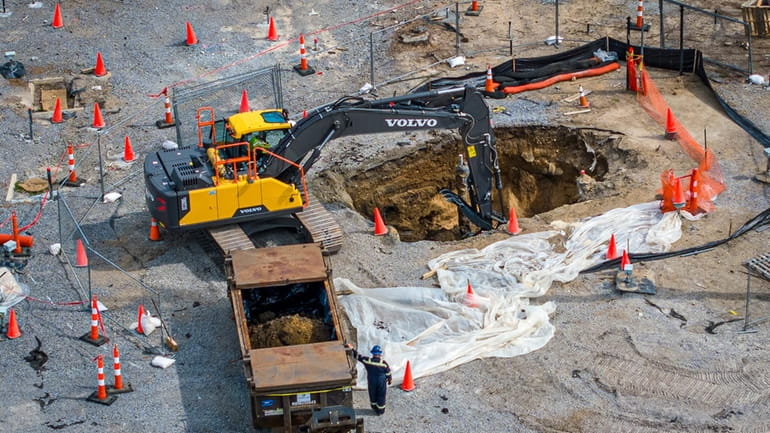Six more chemical drums pulled from pit at Bethpage Community Park

Ongoing exacavation work at Bethpage Community Park has led to the recovery of 16 concrete-encased chemical drums. Credit: Newsday/J. Conrad Williams Jr.
Workers dug up six more concrete-encased chemical drums Wednesday from a pit at Bethpage Community Park, bringing to 16 the number of drums removed from the site of a former chemical dumping ground for Grumman Aerospace, according to state officials and Oyster Bay spokesman Brian Nevin.
The drums recovered Wednesday had been encased in a third layer of concrete discovered on Tuesday. Contract workers for Northrop Grumman had removed a set of four barrels from a second layer of concrete Monday.
On March 28, the contractors discovered an initial layer of six concrete-encased 55-gallon drums about four feet below the surface as they drilled a well on the former ballfields to check an existing soil treatment system at the park.
Testing confirmed those drums contained waste petroleum and chlorinated solvents — chemicals that are “consistent with known historic operations” of Grumman and the U.S. Navy, as well as the focus of an ongoing cleanup effort on the property, according to the state Department of Environmental Conservation.
The DEC has maintained that removal of the drums presents no immediate threat to public health and safety at the site. The agency said it will be conducting additional searches to ensure there are no more drums outside of the current excavation area.
An initial investigation indicated there is not another layer of concrete buried beneath the latest excavated layer, officials said.
Sean Mahar, interim DEC commissioner, previously said the first two layers of drums did not leak into the environment. Northrop Grumman will continue to use ground-penetrating radar to scan the park to see if other materials are hidden underground, he said.
Oyster Bay Supervisor Joseph Saladino said in a statement that scanning “has identified anomalies near the current dig site.” He said the town has demanded that area be excavated next.
The site is where Northrop Grumman’s corporate predecessor, Grumman Aerospace, dumped hazardous materials decades ago. That dumping was found to be a major contributor to an expansive underground carcinogenic chemical plume that is more than 4 miles long, 2 miles wide and 900 feet deep.
The plume continues to move south at the rate of about a foot per day, Newsday has reported.
Grumman donated land for the park to the town in 1962, and contamination was found in the soil in 2002. The town sued the company over a ballfield area soil cleanup agreement from 2013.
Workers dug up six more concrete-encased chemical drums Wednesday from a pit at Bethpage Community Park, bringing to 16 the number of drums removed from the site of a former chemical dumping ground for Grumman Aerospace, according to state officials and Oyster Bay spokesman Brian Nevin.
The drums recovered Wednesday had been encased in a third layer of concrete discovered on Tuesday. Contract workers for Northrop Grumman had removed a set of four barrels from a second layer of concrete Monday.
On March 28, the contractors discovered an initial layer of six concrete-encased 55-gallon drums about four feet below the surface as they drilled a well on the former ballfields to check an existing soil treatment system at the park.
Testing confirmed those drums contained waste petroleum and chlorinated solvents — chemicals that are “consistent with known historic operations” of Grumman and the U.S. Navy, as well as the focus of an ongoing cleanup effort on the property, according to the state Department of Environmental Conservation.
The DEC has maintained that removal of the drums presents no immediate threat to public health and safety at the site. The agency said it will be conducting additional searches to ensure there are no more drums outside of the current excavation area.
An initial investigation indicated there is not another layer of concrete buried beneath the latest excavated layer, officials said.
Sean Mahar, interim DEC commissioner, previously said the first two layers of drums did not leak into the environment. Northrop Grumman will continue to use ground-penetrating radar to scan the park to see if other materials are hidden underground, he said.
Oyster Bay Supervisor Joseph Saladino said in a statement that scanning “has identified anomalies near the current dig site.” He said the town has demanded that area be excavated next.
The site is where Northrop Grumman’s corporate predecessor, Grumman Aerospace, dumped hazardous materials decades ago. That dumping was found to be a major contributor to an expansive underground carcinogenic chemical plume that is more than 4 miles long, 2 miles wide and 900 feet deep.
The plume continues to move south at the rate of about a foot per day, Newsday has reported.
Grumman donated land for the park to the town in 1962, and contamination was found in the soil in 2002. The town sued the company over a ballfield area soil cleanup agreement from 2013.
Updated 55 minutes ago Body parts case continues ... Historic Brentwood home ... Islanders big game tonight ... Montauk ice problem
Updated 55 minutes ago Body parts case continues ... Historic Brentwood home ... Islanders big game tonight ... Montauk ice problem

